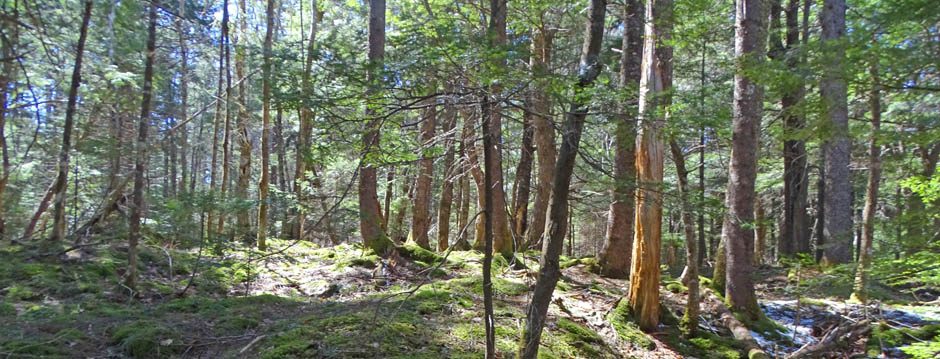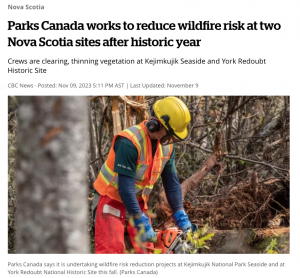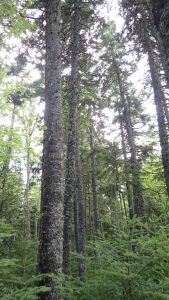Posted 23 Nov 2023
A few edits 24 Nov 2023
Following are my thoughts about some public comments made by Forest NS about the wildfires in NS in 2023 and how to reduce wildfire risk in future. (For Nova Scotia, 2023 was the “most devastating wildfire season on record” – CBC Oct 30, 2023) – David P
Who is “Forest NS”? “Forest NS” is a short for “Forest Nova Scotia”
From Forest Nova Scotia on linkedin.com: “Forest Nova Scotia is the largest organization of forest interests in the province of Nova Scotia, on the East coast of Canada. Since 1934, the association has served as “the voice” of the forest industry in Nova Scotia, representing its 600+ members from all parts of the industry.”
It should be noted that while Forest NS is the largest private woodlot owner/operator association in NS, there are between 10,000 and 30,000 private woodlot owners in NS, managing lots of 20 ha to 200o ha, collectively accounting for about 2/3rds of NS forests*, and that there are several other private woodlot associations.
*Source: Cited in Public importance of private woodlots, by Ethan Lycan-Lang in Morning File (Halifax Examiner), referencing Small Woodlots and the Value of Ecological Forestry, Hansard/Nova Scotia Legislature Proceedings for the Committee on Natural Resources and Economic Development, May 22, 2033.
It is with some reticence that I write this piece after the many years it has taken to reach a broad consensus in NS on how to manage our Crown land forests (although not our private land forests). However, it seems we have no venue now for carrying on the types of discussions that got us there and Forest NS is making some very provocative assertions.
So I hope these comments will stimulate some broader, thoughtful and respectful discussion of the topics by folks more knowledgable about them than I am – including by Forest NS.
Nov 9, 2023
Excerpts from a Post on Forest NS Facebook Page, Nov 9, 2023; with a link to CBC Facebook page with news item of Nov 9, 2023 – Parks Canada works to reduce wildfire risk at two Nova Scotia sites after historic year. (View same item on CBC website)
What’s Parks Canada doing to reduce wildfire risk?
Active forest management.
In Nova Scotia, conducting active forest management is more challenging than ever.
Following the closure of Northern Pulp, the contractor capacity collapsed by 40 percent. That means the number of men and women who work in the woods declined. Those are the people who thin and harvest…
There is no economical way to clean up the forest without a place to sell it.
This means massive numbers of downed trees remain in our forests. These trees will dry up and create increased wildfire risk.
As these downed trees age and die, they will release the carbon they’ve captured, worsening climate change.
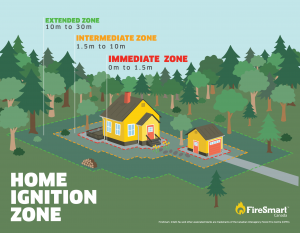 From FireSmart Canada. View PDF with description of zones COMMENT by David P on the Nov 9, 2023 post by Forest NS on their Facebook Page I am guessing that Forest NS folks know better. They know that if we applied the FireSmart practices used to protect structures at the edges of forested areas from fire over all of our forests, there would be very little forest – especially evergreens – as we know it left for forestry or wildlife! There is a big difference between thinning for FireSmart level of protection of structures from wildfires, and thinning to produce wood. |
Nov 16, 2023
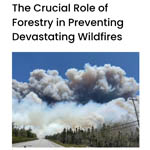 – The Crucial Role of Forestry in Preventing Devastating Wildfires
– The Crucial Role of Forestry in Preventing Devastating Wildfires
Post on Forest Nova Scotia Blog Page
It begins by citing a CBC interview with Scott Tingley, the forest protection manager for DNRR. The link as provided didn’t work (Nov 17, 2023, a.m.), but evidently refers to this item: Nova Scotia saw its most devastating wildfire season on record in 2023 (CBC News · Posted: Oct 30, 2023); there is an associated Cape Breton CBC radio interview.
Excerpts from the Blog Post:
Why we will continue to see more dangerous wildfires
We will see more fires because it is getting harder to manage our forests actively. Active management means properly managing and harvesting in the forest and thinning areas where harvesting isn’t allowed.
Following the closure of the Northern Pulp mill in Pictou County, the number of people…
If forestry professionals cannot actively manage our forests, we cannot remove dead and dry wood. This means the amount of forest fire fuel is increasing.
Many people say that we just need to plant more hardwood. It’s not that simple. Nova Scotia’s wildfires this summer completely burnt multiple hardwood stands. Yes, hardwood is more resilient to wildfires, but it is not fireproof. With massive amounts of forest fire fuel on the ground, hardwood will burn, too. And hardwood doesn’t create lumber to build homes.
A 2022 publication shows that active forest management in Nordic countries is helping sequester more carbon, making forests more resilient to wildfires…
Our push to protect more and more of the forest will add to wildfire risk and result in our forests becoming net emitters of carbon. A recent Parks Canada study drives home this fact…
We are facing increased wildfire risk because our forests are not as actively managed as they should be, and fewer women and men work in the woods.”
Nov 22, 2023
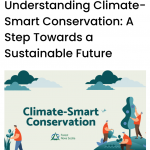 – Understanding Climate-Smart Conservation: A Step Towards a Sustainable Future
– Understanding Climate-Smart Conservation: A Step Towards a Sustainable Future
Post on Forest Nova Scotia Blog Page
Excerpts from the Blog Post:
“…In Nova Scotia, there are two big problems with the current model used to protect land. [It] Increases Wildfire Risk…[It] Hastens Climate Change]
A January 2022 publication by the International Boreal Forest Researchers Association shows that active forest management in Nordic countries is helping sequester more carbon and making forests more resilient to wildfires.
Climate-Smart Conservation means we must start counting private land that is already protected. Large areas of private land cannot be forested for legislative or regulatory purposes. Failure to count this land will be expensive for taxpayers and our environment… This approach would let the province accurately count the amount of land already protected in the area. In doing so, we could avoid worsening climate change and increasing wildfire risk by protecting too much land.
| COMMENT by David P on the Nov 16 and Nov 22, 2023 posts by Forest NS on their Blog Page
Forest NS’s reference to concerns about increased wildfire in national parks as evidence that protecting forests (for wildlife and non industrial uses) increases fire risk is surely misleading; read the referenced Parks Canada study: nowhere is there any evidence or discussion that the protected status contributed to the increase in wildfires. By the same logic, I could infer that as some manually thinned woodlots burned in 2023 (and some did), forest management is a contributing factor. In regard to Forest NS’s reference to the a publication by the International Boreal Forest Researchers Association: there are no firm conclusions presented in that paper regarding thinning and fire, e.g. from page 15″ In Finland and Sweden a few thinnings are conducted per rotation, while thinnings are uncommon in Norway. Forest fires are effectively prevented in all three countries.” They comment that forest management (versus no forest management) has reduced fires in Nordic countries through road-building which enables fires to be out out more quickly. In regard to what burned in NS in 2023, national fire expert Ellen Whitman has commented “Those fires burned in conifer-dominated areas ” (Whitman interviewed by S. Rent, Halifax Examiner, June 8, 2023); presumably her comments were based on information provided by local experts or inferred from examination of forest vegetation maps, e.g. as illustrated on this website for Tantallon area and Shelburne area. Regardless, we need to learn what we can from an objective analysis of areas/vegetation types/soils etc. that burned in the forest fires in NS in 2023, and of those in the path of the fire that did not, in order to improve fire prediction models for NS. I assume that’s happening. Hopefully the results will be shared publicly. In regard to thinning as a panacea to reduce risk from wildfires in NS, yes, intense thinning and species selection (avoiding softwoods) a la FireSmart makes sense at the wildland-urban interface, but blanket thinning to whole forests in NS as a means of reducing wildfires has little basis in the scientific literature – see literature cited under Fire Prediction & Forest Mgmt and More on Thinning on this website. The effects of manual thinning on wildfire are very site specific, in some situations reducing risk or intensity or spread of wildfire, in others, increasing the fire hazard. At best, the contention that blanket thinning reduces wildland fires is scientifically controversial. From my reading, the role of thinning to reduce wildfire hazard is well summed up by the following:
It’s perhaps not common knowledge that forests “self thin” in the process of forest succession. After clear cutting or a natural stand-level disturbance, a forest stand goes through a successional process including a “Pole Stage” of very dense, young trees. Over time these stands “self thin’ and as a result, older Mature and Old Growth stage stands naturally have much lower tree density than in the Pole Stage – without any need for thinning or pruning of lower branches by foresters. Interestingly, an Australian fire expert reports that “Our findings indicate that self-thinning forest understoreys result in long-term reductions in fire risk that are robust even in the face of global warming.” and comments “Ignoring these long-term dynamics can introduce a misleading anthropocentric conceptualization of fire in forests, in which human intervention is needed to minimise the risks of fire.”*  Gap dynamics in mature mixed, unmanaged Wabanaki (Acadian) Forest. A: recent blowdown creates a gap in forest, B: dense Pole Stage forest in an older gap, C: Mature Forest with widely spaced trees, pit & mound topography. Progression from B to C occurs by self-thinning. Thinning by foresters is conducted, as I understand it, to essentially eliminate a lot of the time required for natural self-thinning by conducting manual thinning and so reduce the time it takes to produce trees that can be used for lumber; it is also conducted to produce more larger diameter trees (which are more valued as timber) in the mix than might occur naturally. Some say manual thinning produces “healthier trees”, but there is little evidence to support that perspective; many users of wood products say slower growing trees produce stronger wood (see discussion of “Does thinning make a tree or stand healthy“). Forest thnning can affect hyrdological processes adversely from a human perspective; effects on biodiversity are site, time and species specific; some adverse effects can be ameliorated by modifying thinning practices. In the days gone by when there were many more older trees and larger volumes of merchantable timber in our forests, many or most woodlot owners left patches of forest to self thin; they did much less manual thinning, if any, compared to today.* They didn’t need to in order to obtain the wood they wanted. But there was a lot of over-harvesting/high-grading as well because the supply seemed limitless and over time, the standing stocks of merchantable wood declined; silvicultural practices including thinning were introduced to produce more merchantable wood from the same areas over shorter intervals than if they had to wait for nature to do it all. Plantations go several steps further with soil prep., fertilization, use of selected genotypes etc. and accordingly produce even more wood, faster – but at the same time eliminate many or most of the “Ecosystem Services” of unharvested forests (although they may provide more such services than on “lands that have been degraded or previously deforested”). Because of over-harvesting and negative impacts of industrial forestry – as commonly practiced today – on Ecosystem Services, as a society we have agreed that it is necessary to ban forestry and many other types of human activities on large tracts of forest land, to “protect” them* as we call it. Recently, in Nova Scotia, we have agreed to formally implement the TRIAD system of forest management as elaborated by Robert Seymour & colleagues on our Crown lands.
It was a protracted process to get us to this point in NS; we went through the Natural Resources Strategy process 2008-2011; Forest NS (then FPANS) and others in the ‘Big Forestry’ camp fought successfully to discredit the process in the eyes of government and many of its recommendations including restrictions on clearcutting on private lands were never implemented. Since then it seems that in NS, we have at least tacitly agreed that on private lands, which account for approx. 2/3rds of the forested lands in NS, owners should have much more discretion as to how to manage their forests than we allow on our Crown lands. Clearcutting continued with few restrictions on both Crown and private lands, but with increasing concerns expressed by citizens. Then we had the Independent Review of Forest Practices (2017-2018, aka the “Lahey Report”). There was broad support for the recommendations which the Liberal government followed by the PC government began to implement, at least in part* The key recommendation was to implement the TRIAD on Crown land. Support for this recommendation was not unequivocal, rather it was seen as an appropriate and necessary compromise between what was desired by the ‘environmental camp’ and that desired by the ‘Big Forestry camp’ – to over-simplify positions – and indeed, such compromise is some of the raison d’être of TRIAD forestry. The major raison d’être of the TRIAD is that “foresters recognized that expanding the use of high‐yield, commodity‐production silviculture (via planting and early competition and density control) could, at least in the long run, offset any “loss” of timber productivity to forest reserves” (Forbes, 2019), i.e. it can enable us to produce as much or more wood than we have in the past under other management systems AND do a better job at conserving native biodiversity and other ecosystem services at the same time. Nova Scotia’s adoption of the TRIAD on Crown lands is recognized as “the largest scale implementation of the triad approach” (Austin Hines, 2020). It’s a bold initiative, being watched closely (Betts et al., 2021; Himes et al., 2022), and requires continuing “Goodwill, trust, maturity and wisdom from all players” (Pulsifer and McIntyre, 2020) to succeed. However, Forest NS contends that in 2023, because of the increased threat of wildfire under climate warming, we need to actively thin all forested land.
That means building roads and many other intrusions into our Parks Protected Areas, and to privately owned forested lands that are not harvested. One consequence: we would no longer be allowed to count the thinned forests in our Protected areas as ‘protected’ and there would be real losses in biodiversity because of habitat degradation and fragmentation. Regardless, it is an argument seemingly not based on detailed consideration of the science of wildfire, or on detailed analysis on the fires of this past year, or on any longer term trends – a few months in 2023 is hardly a trend. Look at the rains we received subsequently, also not yet a trend but if it is, our forests will likely hold much moisture than they had leading up to the fires of 2023. Nor does Forest NS cite a variety of other precautionary practices that can be used to reduce wildfire frequency or damage, such as burning slash piles, attention to fire hazards associated with use of tools and vehicles in the woods (e.g. fire started in NS in 2020 by metal machine tracks) or the use of prescribed fire more generally. It’s difficult not to conclude that Forest NS’s contention that we are “worsening climate change and increasing wildfire risk by protecting too much land” and focussing only on thinning as a tool to reduce wildfire risk is a thinly veiled attempt to gain access to public and private lands where logging is not currently permitted. Hopefully, Forest NS can come up with more considered and constructive comments on how forest management might have influenced the fires in 2023, and on best practices to reduce frequency of wildfire and the risk to structures and life from wildfires whether more common or not in future. |
Postscript: One comment of Forest NS in their most recent post that I do largely agree with… is the suggestion that “we must start counting private land that is already protected” (although I do not agree with their rationale that “In doing so, we could avoid worsening climate change and increasing wildfire risk by protecting too much land”). They cite as examples to:
- Include Moose Reserve Patches or Moose Shelter Patches already reserved from harvest on private land.
- Include wetlands and the riparian zones around wetlands where harvesting and other industrial activity do not occur.
- Include riparian areas around lakes and along larger watercourses.
- Voluntary conservation easements are offered to private landowners – they give a guarantee not to harvest or work the land.

Minimally disturbed 50+ years and owner wants to keep it that way in perpetuity. (Privately held land on the Chebucto Peninsula)
I especially support the last-mentioned item. I have frequently been asked to have a look at a piece private for its ‘conservation. value’ because the landowners are wanting to formally protect the land from future development, and in order to do so it must have some special conservation value such as presence of Species-at-Risk. It is not enough, for example, to host largely undisturbed mature forest with patches of Old Ggrowth. But such lands provide most of the Ecosystem Services provided by formally protected lands. So thanks for bringing that one up Forest NS.
I assume that our provincial government is looking into such matters as the four examples above are all potential “OECMs” (Other Effective area based Conservation Measures) and these are cited in the NS Government’s Environmental Goals and Climate Change Reduction Act:
Land protection goals
10 The Government’s goals with respect to the protection of land are (a) to conserve at least 20% of the total land and water mass of the Province by 2030 as protected areas and other effective area-based conservation measures, including Indigenous Protected and Conserved Areas, in a manner consistent with national reporting criteria.
Also view:
– Consultation Open on: Protected Areas and Other Effective Area-Based Conservation Measures in Canada: A Guidebook for Their Identification and for the Application of IUCN Protected Area Categories
Canadian Council on Ecological Areas, Consultation Draft Version 1. May, 2018
– A Path to Protection: Making OECMs Count
Samantha Cava for Ontario Nature, Jan 30, 2020
– OECM concept may bring more inclusive approach to conserving biodiversity (2021)
Jim Tan for MongaBay News, Sep 13, 2021
– Case Studies on Existing and Potential OECMs Categorised by Type of Resource Use (Terrestrial and Marine)
IUCN, 2022

Minimally disturbed 50+ years and owner wants to keep it that way in perpetuity.
(Privately held land on the Chebucto Peninsula)
——
Also view
Logging in disguise: How forest thinning is making wildfires worse<
Chad T. Hanson in www.grist.org Aug 24, 2021. “The U.S. Forest Service clears trees from public lands in the name of fire prevention, but it doesn’t work. There are better strategies to protect communities, but don’t expect to hear about them from the logging industry. Chad Hanson is an ecologist with the John Muir Project and the author of Smokescreen: Debunking Wildfire Myths to Save Our Forests and Our Climate (University Press Kentucky, May 2021).”
